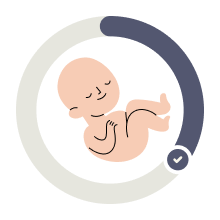Reaching week 20 of your pregnancy signifies the halfway point in this incredible journey.
You’ve likely experienced a multitude of physical changes and have been mindful of your diet and activities for the well-being of your baby. However, it’s equally vital to prioritize self-care.
Pregnancy Week 20 Quick Facts
- At 20 weeks, you’re five months pregnant
- You have 20 weeks until your due time “Calculate your due date”
- You’re in your second trimester
Your Unborn Baby’s Size at 20 Weeks
Imagine holding a banana in your hand – that’s about the size of your unborn baby at week 20! The fetus measures around 6.46 inches in length and weighs approximately 10.58 ounces.
Pregnancy Symptoms Week 20
Throughout this week, you might experience persistent second-trimester symptoms, such as heartburn, nasal congestion, and food cravings. Additionally, you may observe changes in your belly button, gain weight, and cope with distressing leg cramps.
Weight gain: As per the standard pregnancy weight gain guidelines, it’s anticipated to gain about 1 pound every week for the remainder of your pregnancy after a weight gain of 1 to 5 pounds in the first trimester. The weight gain is a result of various factors, including the baby’s weight, uterus, amniotic fluid, placenta, and an increase in blood volume and breast tissue.
Belly Button changes: As your uterus expands and grows in your abdomen, it exerts pressure on your abdominal wall, which can affect the appearance of your belly button. While not everyone experiences this change, an inner belly button may become flattened or even protrude outward, creating an “outie” appearance. It’s important to note that this change is usually temporary and harmless, and there’s typically no way to prevent it from happening.
Self-Care Tips:
Make sure to maintain a healthy diet, stay hydrated, engage in safe physical activities, and consistently take your prenatal vitamins. Additionally, consider finding effective ways to alleviate leg cramps and start sleeping on your side if you haven’t already.
Avoid Lying on Your Back
As you reach 20 weeks, it’s important to avoid lying flat on your back. The size of your uterus and baby can create pressure on your abdominal organs, spine, and major blood vessels, which can impact circulation, slow blood flow to your heart, and potentially lower your blood pressure.
Sleep on your side: Use pillows or a wedge to help you stay comfortably on your side throughout the night, preventing accidental rolling onto your back.
Stay mindful of your sleeping position: Be aware of your body posture while sleeping, and avoid lying flat on your back for extended periods.
Avoid lying flat on your back during pregnancy to protect your abdominal organs and blood vessels, and consult with a qualified fitness professional for safe exercise modifications.
Prenatal Tests and Doctor’s Appointments
You might have a prenatal appointment scheduled for this week, during which your physician or midwife will perform the following routine tasks:
- Record your weight
- Check your blood pressure
- Request a urine sample
- Discuss your symptoms with you and Examine your body for any signs of swelling
Ultrasound: During your 20-week prenatal visit, you may have a scheduled structural ultrasound, also known as the anatomy scan or level 2 ultrasound. A technician will apply a thin layer of cold jelly on your abdomen and use a hand-held transducer to carefully examine your developing baby.
This comprehensive ultrasound provides a detailed assessment of your baby’s body parts, organs, umbilical cord, placenta, and amniotic fluid. If you’re interested, and if your baby’s position allows, you may also be able to find out the baby’s sex during this scan.
The structural ultrasound is an important diagnostic tool that can provide valuable information about your baby’s growth and development, and it offers a special opportunity to get a glimpse of your little one before they arrive.
– Risk in the 20th week of pregnancy
If you or your baby have a medical condition, such as diabetes or high blood pressure, your pregnancy may be considered high-risk. This designation may require more frequent visits with your healthcare professionals and additional checks throughout your pregnancy. Depending on the nature of the medical condition, you may also need to consult with specialists to ensure proper management and monitoring.
Developmental Milestones
In terms of the reproductive system, significant developments have taken place:
Female: The development of human egg cells begins before birth, and by 20 weeks, there are about six to seven million eggs in the ovaries. However, this number starts to decrease from this point onwards and continues to decline throughout life.
Male: The testes are still located in the abdomen, preparing to move to the inguinal area (groin) for their descent. However, it is typically not until the third trimester that the testes descend into the scrotum.
Other developments at this stage include the continued build-up of vernix, a protective layer on the skin. Hair follicles are also getting longer, and eccrine sweat glands are beginning to form. Additionally, the gallbladder is producing bile to aid in the digestion of nutrients.



